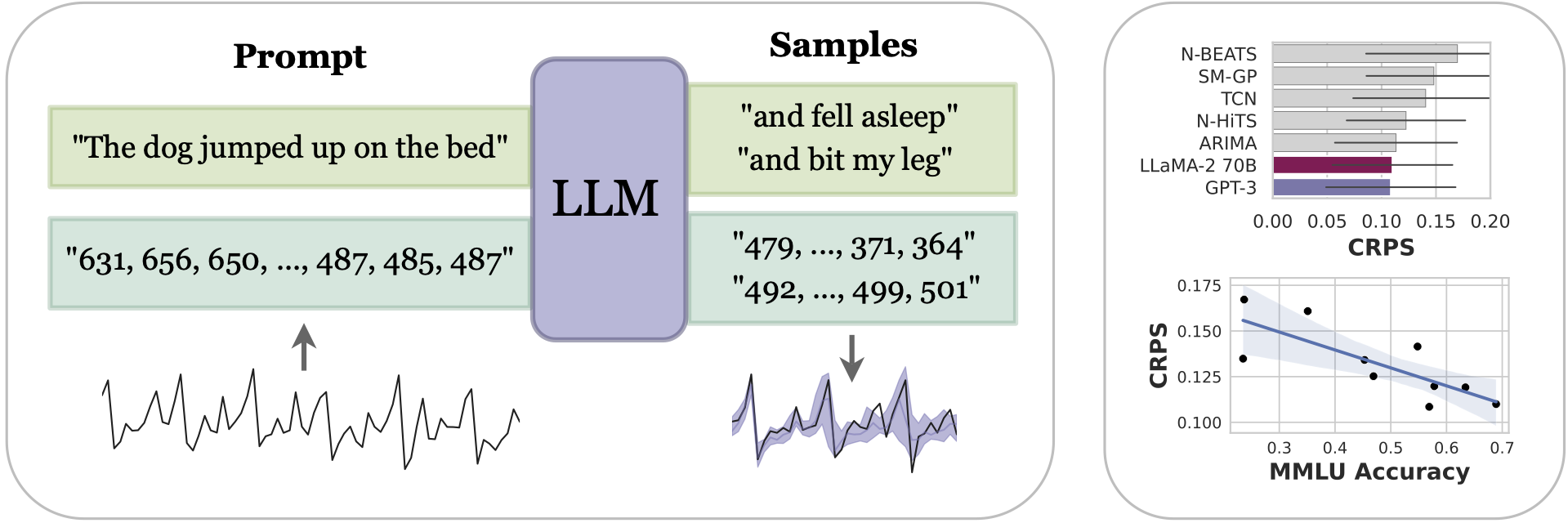This repository contains the code for the paper Large Language Models Are Zero Shot Time Series Forecasters by Nate Gruver, Marc Finzi, Shikai Qiu and Andrew Gordon Wilson (NeurIPS 2023).
We propose LLMTime, a method for zero-shot time series forecasting with large language models (LLMs) by encoding numbers as text and sampling possible extrapolations as text completions. LLMTime can outperform many popular timeseries methods without any training on the target dataset (i.e. zero shot). The performance of LLMTime also scales with the power of the underlying base model. However, models that undergo alignment (e.g. RLHF) do not follow the scaling trend. For example, GPT-4 demonstrates inferior performance to GPT-3.Run the following command to install all dependencies in a conda environment named llmtime. Change the cuda version for torch if you don't have cuda 11.8.
source install.sh
After installation, activate the environment with
conda activate llmtime
If you prefer not using conda, you can also install the dependencies listed in install.sh manually.
If you want to run OpenAI models through their API (doesn't require access to a GPU), add your openai api key to ~/.bashrc with
echo "export OPENAI_API_KEY=<your key>" >> ~/.bashrc
Finally, if you have a diffferent OpenAI API base, change it in your ~/.bashrc with
echo "export OPENAI_API_BASE=<your base url>" >> ~/.bashrc
Want a quick taste of the power of LLMTime? Run the quick demo in the demo.ipynb notebook. No GPUs required!
We currently support GPT-3, GPT-3.5, GPT-4, Mistral, and LLaMA 2. It's easy to plug in other LLMs by simply specifying how to generate text completions from them in models/llms.py.
To run Mistral models, add your mistral api key to ~/.bashrc with
echo "export MISTRAL_KEY=<your key>" >> ~/.bashrc
Here are some tips for using LLMTime:
- Performance is not too sensitive to the data scaling hyperparameters
alpha, beta, basic. A good default isalpha=0.95, beta=0.3, basic=False. For data exhibiting symmetry around 0 (e.g. a sine wave), we recommend settingbasic=Trueto avoid shifting the data. - The recently released
gpt-3.5-turbo-instructseems to require a lower temperature (e.g. 0.3) than other models, and tends to not outperformtext-davinci-003from our limited experiments. - Tuning hyperparameters based on validation likelihoods, as done by
get_autotuned_predictions_data, will often yield better test likelihoods, but won't necessarily yield better samples.
Run the following commands to replicate the experiments in the paper. The outputs will be saved in ./outputs/. You can use visualize.ipynb to visualize the results. We also provide precomputed outputs used in the paper in ./precomputed_outputs/.
python -m experiments.run_darts
You can download preprocessing data from here or use the following command
gdown 'https://drive.google.com/uc?id=1sKrpWbD3LvLQ_e5lWgX3wJqT50sTd1aZ'
Then extract the data (the extracted data will be in ./datasets/monash/)
tar -xzvf monash.tar.gz
Then run the experiment
python -m experiments.run_monash
python -m experiments.run_synthetic
python -m experiments.run_missing
python -m experiments.run_memorization
Please cite our work as:
@inproceedings{gruver2023llmtime,
title={{Large Language Models Are Zero Shot Time Series Forecasters}},
author={Nate Gruver, Marc Finzi, Shikai Qiu and Andrew Gordon Wilson},
booktitle={Advances in Neural Information Processing Systems},
year={2023}
}